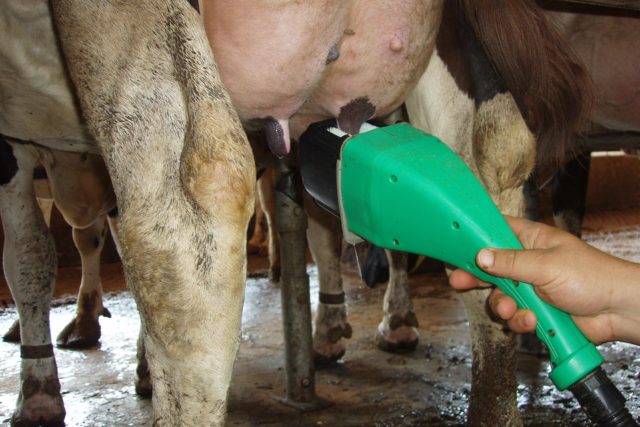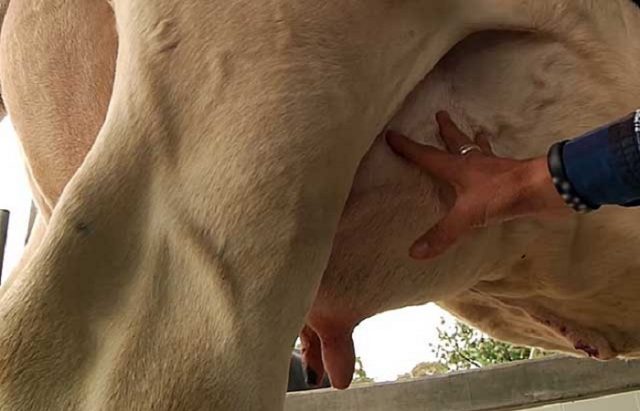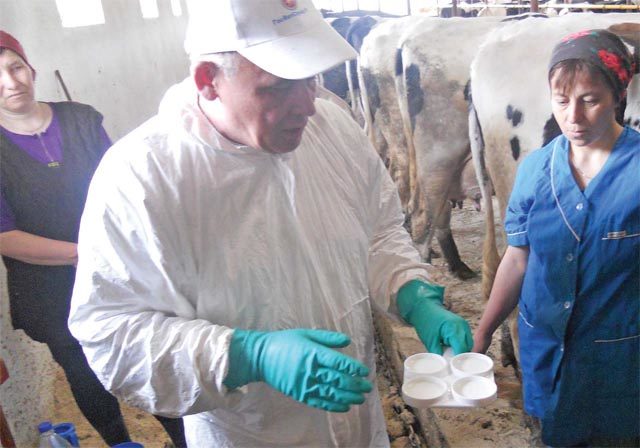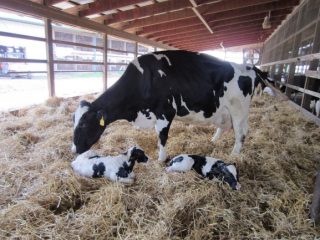Content
Treatment of milk stone in a cow is an important therapeutic measure, on which the further productivity of the animal will depend. The causes of the pathology are varied, but more often they are associated with improper milking of milk from the udder of a cow. Treatment is quite successful with a timely detected disease.
What are milk stones
Milk stone is the deposition of certain salts, in particular calcium and phosphorus, in the mammary glands of a cow, the so-called calcification process. It is a non-communicable cattle disease. The livestock breeder may notice small stones during milking, since fine sand will be present in the milk. Larger stones cannot come out on their own, they get stuck in the milk passages and make milking more difficult. Sometimes they connect to each other, get larger. In terms of density, stones can be different - hard, soft, loose, elastic. If you do not start treatment when the first symptoms appear, then the disease can develop into mastitis or some other pathology. Typically, veterinarians recommend revising the cow's diet. There is obviously some imbalance in minerals.
The mammary glands, the udder of an animal are a very delicate organ that requires careful attention from the breeder during milking and care. Often the udder is exposed to external factors, injuries, infectious diseases, and inflammatory processes. This affects the quantity and quality of dairy products. However, the disease responds well to treatment and rarely has complications.
Causes of Milk Stone Formation in Cows
Milk stone disease is more often observed in individuals over 5 years old. The main cause of the pathology is the retention of milk, its incomplete milking from the udder. Salts are formed in milk residues, which are then converted into milk stones. There are a number of other reasons for the development of the disease in a cow:
- violation of metabolic processes in the body of an animal;
- inflammatory processes of the walls of the milk tract;
- non-compliance with hygiene standards;
- imbalance of trace elements.
During milking, sand, small stones in the teat of a cow can be easily felt through the skin.
Milk stones immediately after calving are nothing more than sugared colostrum. As a rule, in this case, there is no cause for concern.
Symptoms of milk stones in cows
At the onset of the disease, you can find some swelling of the udder, on palpation, minor foci of seals are felt. Milk may decrease. As the disease progresses, the animal shows some anxiety, looks back, hums. This suggests that the individual is experiencing pain. At the same time, the lymph nodes in the udder area slightly increase. Milk stones, the largest in size, are felt through the nipples. At this stage of the disease, milk production decreases quite significantly.
As a rule, lactic acid disease is observed throughout the udder, while inflammatory processes are not detected. The appearance of milk practically does not change, only small grains of sand appear at the beginning of milking, in the first portions of milk. However, in laboratory studies, increased acidity, a low percentage of fat content is determined.
Milkstone disease should be differentiated from mastitis. With the development of this pathology, the temperature of one or more lobes of the mammary gland rises.At the same time, the body temperature is lowered. Milk from a cow with mastitis should not be eaten. At the same time, it is recommended to prepare fermented milk products from milk from an individual with a history of milk-stone disease.
How to treat milk stone in a cow
Veterinarians offer several options for getting rid of milk stones from a cow:
- massage before and after milking;
- the use of a catheter;
- surgical intervention;
- drug treatment;
- exposure to ultrasound.
Daily massage helps to get rid of stones. Before milking, the udder is washed with warm water, wiped off with a clean towel and the massage is started. It should be done carefully, stroking the udder from top to bottom to the nipples, and then in the lateral directions. After that, they move on to the nipples. They are squeezed to release milk. After that, wipe the udder with a hard napkin. The massage should be done before and after milking.
The catheter can be used to remove loose lumps from the cow's teats. First, a special solution is introduced into the tank, which crushes the stones, and then during milking they are carefully squeezed out of the teats with milk.
Sometimes surgery is required if the stones are too large. To do this, the tank is opened, sutures are applied, stony formations are removed from the cow's udder, or a catheter is attached to her for a while.
Intravenous administration of oxytocin contributes to the rapid restoration of all properties of milk. The agent is administered within 1 week. Recovery occurs in 2-3 weeks.
An effective way to deal with milk stones in a cow is ultrasound. First, it is prepared for the procedure: the udder is washed and shaved, treated with a disinfectant solution and coated with glycerin. The device is driven along the udder of a cow, gradually increasing the radiation power and exposure time. The manipulation is carried out daily. It will take from 2 to 10 sessions, depending on the degree of the disease. Ultrasound allows the drugs to enter the cow's body faster.
The treatment of milk stone in a cow is described in the video.
Bougie is often used for treatment. It is introduced into the canal and left for several minutes. Then they use a bougie of a wider diameter, and increase the exposure time. The procedure can be repeated every three days.
Preventive actions
Intramuscular administration of oxytocin is also used to prevent milk stones in cows. But it is better to completely, to the last drop, milk the cow and take care of the udder in accordance with hygiene standards. The formation of milk stones in a cow can be affected by improper starting. Often, due to a decrease in the number of milkings and regular milk retention, the process of stone formation is greatly enhanced.
Animals should be closely monitored immediately after calving. During the colostrum period, they should be milked at least 5-6 times a day. It is at this time that many milk stones come out of the udder of a cow. If they are retained in the gland, the milk ducts become clogged.
Conclusion
Milk stone treatment in a cow is a must for any cattle owner. For many highly productive dairy cows, this disease is very common. It does not cause significant economic damage, does not greatly affect the health of the animal, is quickly treatable, and does not cause complications. Like any other pathology, lactic acid disease should be treated in time.












